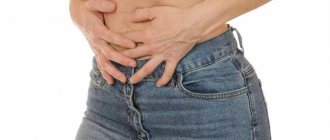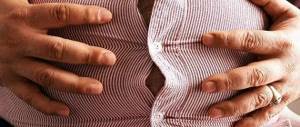Causes of abdominal pain in children 4 years old
There are many causes of discomfort and abdominal pain in children, but they should be identified before giving children medications in order to directly influence the factor that caused the deviation.
The main cause of abdominal pain in children of this age period is the functioning of the digestive tract, which results in frequent overload of the stomach with consumed food. As a result, a change in the functioning of the gastrointestinal tract occurs, which causes inconvenience that young children associate with pain.
If the child’s pain and complaints intensify, attention should be paid to other causes, including acute attacks, which require immediately calling a doctor and examining the little patient.
The causes of severe pain can be pathologies such as:
- Constipation - to identify this cause, it is necessary to find out when the child went to the toilet most of the time. The absence of stool for 2-3 days causes pain and bloating.
- Bloating - in children 4 years of age, this condition usually occurs after eating foods that affect the condition of the intestines and increase the process of gas formation.
- Appendicitis is an acute condition characterized by first widespread pain in the abdomen, and then the pain moving to the lower right area of the abdomen. This condition requires immediate hospitalization of the child;
- Worm infestations - in this case, the child is restless and constantly wants to scratch the anus. Pain usually occurs as a result of intestinal bloating, in which roundworms appear.
These are the most common causes of abdominal pain in children 4 years old. However, one should not exclude from attention such factors as diseases of the kidneys, pancreas, and gallbladder, which can also cause pain in the abdomen. In addition, infectious diseases can also cause abdominal pain.
Constipation in children
This disruption of intestinal function is familiar to many. There are many reasons for its occurrence:
- improper functioning of the colon (more often this occurs in infants);
- various diseases accompanied by an increase in body temperature - at high temperatures, dehydration occurs, which makes bowel movements difficult;
- stress;
- change in diet and quality of food;
- climate change, etc.
With constipation pain in the abdomen , symptoms of intoxication appear, and the stomach “gurgles” - all this becomes a reason to consult a doctor.
What to do if your baby is worried about constipation? The first step to relieve your child of constipation is to change his diet :
- Avoiding baked goods, rice, pasta, whole milk, bananas and apples - all these foods cause thickening of the stool, so there is no need to give them to your baby at this time.
- You should not give foods that lead to gas formation: legumes, cabbage, tomatoes - they need to be removed from the diet for a while.
- Drink more clean water.
- Add fermented milk products (kefir, yogurt), vegetables, and grains to your diet.
Of the medications that are approved for use by children as a laxative, the use of Duphalac is possible. And in case of painful sensations in the abdomen (cramps), children may be prescribed No-shpu, Papaverine. However, prescriptions and dosage should be made exclusively by a pediatrician - self-medication is unacceptable .
Gastroenteritis
This is an inflammation of the mucous membrane of the stomach and small intestine. This disease is usually caused by viruses: adenovirus; calicivirus; rotavirus.
But, in addition to viruses, gastroenteritis can also be caused by parasites and bacteria , taking certain medications or under the influence of a number of chemicals.
Symptoms: abdominal (stomach) pain, nausea, vomiting, diarrhea . Sometimes increased body temperature, weakness. Therefore, if a child’s stomach hurts, one should not exclude the possibility that the baby “caught” gastroenteritis.
As first aid for gastroenteritis, the patient should be limited in diet . Due to severe vomiting and diarrhea, dehydration may occur, so you need to increase the amount of drinking water.
It would also be useful to take electrolytes (to restore the salt balance), for example, Regidron, and eubiotics (Linex, Bifidumbacterin, etc.) will help restore the damaged intestinal microflora.
In addition, in the future it will be necessary to take vitamins (vitaminosis often accompanies gastroenteritis). To restore the damaged mucous membrane of the stomach and intestines, drugs that have an enveloping effect are prescribed. In the case of a severe case of the disease, it is necessary to treat the child in a hospital .
Symptoms
The symptoms of the deviation depend on the causes of the pathology. Typically, the main symptom of pain in a 4-year-old child is a change in the child’s behavior, which indicates a disorder.
Abdominal pain in children 4 years old can be detected by the following signs:
- The child refuses to eat and sleep;
- He is restless, constantly tosses and turns and tries to take a forced position;
- The baby cries, indicating discomfort in the tummy;
- When examining the abdominal cavity, the child tenses his abdominal muscles;
- In some cases, the child develops stool disturbances and vomiting;
- The baby's skin becomes pale;
- The baby's pulse and heart rate increase;
- Body temperature increases.
Depending on the cause of the disorder, other symptoms associated with the underlying disease may appear. So, with kidney pathology, urination is impaired, and with stomach diseases, belching may occur. It is important to show the child to a doctor to identify the underlying cause of the disorder.
Flatulence and colic
One of the common causes of abdominal pain in a child is the accumulation of gases. If such symptoms appear in infants under six months of age, it means that the nursing mother is not eating properly or the formula that the baby is fed is not selected correctly. If a child has a stomach ache, traditional medicine can advise what you can give him. In this case, the first aid will be a tummy massage, and if it does not help, then most likely you need to change the mother’s diet or start feeding the baby with a properly selected formula. It is often recommended to give your baby dill water - a decoction of fennel seeds.
There is also a more dangerous cause of flatulence and colic in a baby - a congenital pathology in the intestinal area.
This disease is a problem not only for infants, but also for adolescents. If a child in adolescence complains of symptoms of flatulence, you can try to help him with folk remedies. For example, dull pain and heaviness in the stomach can be relieved by taking dandelion decoction half an hour after eating.
How can you help your child?
For first aid, you should give your child plenty of fluids. If a child experiences vomiting or diarrhea, you should stop feeding the baby until the cause is identified. If your baby's temperature increases, you should give him paracetamol or ibuprofen.
You should not warm the baby’s belly so as not to worsen the symptoms. Warming can cause inflammation in the abdomen. You should give your child medicine only if you are confident that this medicine will help get rid of the cause of the disorder.
We recommend: Adenoid removal in children
You can help your child by applying a cold compress to the stomach. It is important to understand that the abdomen should not be cooled for a long time; the maximum time for applying cold to a child is a period of 10 minutes.
If you are absolutely sure that there are no secondary diseases, you can give your baby symptomatic remedies for bloating, constipation or diarrhea.
Purpose of treatment
Treatment depends on many factors: medical history, the child’s condition, the results of examination and research, and the child’s individual reactions. If the disease that caused the abdominal pain is not particularly dangerous, the child can stay at home. More serious cases require outpatient treatment or even surgery.
At home, the child should be placed on bed rest and ensure sufficient fluid intake to prevent dehydration. Follow a diet; it is better to give food in semi-liquid form. You should not give medications without a doctor’s prescription (especially antibiotics and aspirin) and do not get carried away with traditional medicine methods (for example, uncontrolled use of medicinal herbs).
If the child has a fever, you can give an antipyretic, for example, paracetamol-based drugs. Drug treatment is recommended if the temperature is 38 degrees or higher, and diarrhea or vomiting lasts more than a day.
Treatment
Treatment of abdominal pain should be carried out with medications after identifying the cause of the disease. In some cases, surgical treatment is used.
The main means for treating pain are painkillers, antispasmodics, as well as drugs that reduce symptoms of abnormalities, such as vomiting, nausea (Cerucal, chamomile and celandine decoction, weak solution of potassium permanganate), headaches and fever (paracetamol, ibuprofen, junior ibuclin) .
In the treatment of the disease in children, drugs against diarrhea or constipation are used, depending on the presence of one or another type of defecation disorder. Thus, drugs such as smecta, loperamide, and activated charcoal can be prescribed for diarrhea. Bisacodyl and Microlax microenemas, as well as a cleansing enema, can be taken to treat constipation.
If a surgical acute cause of a disease disorder occurs, therapy is carried out in an inpatient setting, in which the disorder is removed surgically.
Long lasting pain
Before medical help, there is no need to give medications, but you should try to distract the baby’s attention. The indication for treatment in a hospital (or contacting a doctor) is prolonged pain. In this case, the behavior of the little patient is restless and anxious. Various painful sensations for two to three hours without positive dynamics are a reason to seek medical help. Another symptom that indicates you should see a doctor is the presence of blood in the stool or vomit. What should I give my child for stomach pain? More on this later.
In cases of unusual symptoms, it is better to abstain from medications so as not to aggravate the situation. It will be more difficult for doctors to determine the diagnosis while taking pain medication. This could cost the child his life.
The following situation requires a quick response from parents: the child has consumed medication, a harmful substance, or household chemicals. You should not take independent actions, much less resort to folk remedies. And it is necessary to urgently call an ambulance. Also, before the doctor arrives, put the baby down and let him take a comfortable position.
When to call an ambulance
An ambulance should be called if a child experiences persistent complaints of abdominal pain. In addition, there are a number of signs by which it is possible to determine the need to call a doctor to identify a violation. These signs include:
- Very tense abdominal muscles of the child, loud crying and refusal of the child to sleep and eat for a long time.
- The appearance of additional symptoms of the disease - diarrhea, constipation, nausea and vomiting, as well as headaches;
- Night pain;
- Frequently occurring painful sensations against the background of a resting abdomen;
- The occurrence of pain after a strong blow to the child in the peritoneal area;
- Violation of the general condition of the child against the background of pain.
A timely examination will help to avoid complications and deterioration of the child’s condition in case of serious health problems.
Dyspeptic disorders
Such disorders tend to develop in the absence of a sufficient amount of enzymes necessary for digesting food in the intestines. In such cases, children experience a feeling of fullness in the stomach; belching, heaviness in the stomach, nausea and even vomiting are often observed. Often, disturbances in the functioning of the stomach are accompanied by abdominal pain and abnormal bowel movements. In such cases, the child can be cured by radically changing his diet. First of all, you need to immediately eliminate solid foods, soda, caffeine, sweets, fruit juices and milk. Give a few tablets of activated carbon or Mezim.
What to do if your child has a stomach ache
When a child complains of abdominal pain, every mother tries to alleviate the child’s condition, but it should be understood that eliminating the symptoms will not solve the problem. If pain lasts more than three hours, you should consult a doctor for a full examination.
It is important to understand that if a child has prolonged abdominal pain, medications should not be given, since if there is a surgical problem, the abnormality may be hidden when the child is examined by specialists.
If a child is constipated, it is possible to use microenemas that allow you to empty your bowels quickly and painlessly. In case of the opposite situation with defecation, absorbents will help.
If a child experiences abdominal pain, you should not give him heavy food; it is important to control the amount of fluid consumed by the baby.
If symptoms intensify and new signs appear, you should immediately call an ambulance.
Aching in the pit of my stomach
Mild, but very unpleasant pain in the upper abdomen (epigastric region) or in the navel area occurs with gastritis, gastroduodenitis, as well as peptic ulcers of the stomach and duodenum.
Symptoms The baby complains that his stomach is pulling, aching, and twisting. To alleviate his condition, the child sits down, hunched over and clasping his arms around his waist, or lies on his side, bending his legs and pulling his knees to his chest. With gastritis, the stomach begins to ache immediately after eating, and with gastroduodenitis and peptic ulcers - on an empty stomach. As soon as you eat, the pain calms down and then starts again. At the same time, there may be heartburn and sour belching, violent, sometimes even a fountain, constipation or unstable stool (with gastritis).
Help In this case, you need to quickly show the child to a gastroenterologist and follow the diet recommended by him.
Prevention measures
It is easier to prevent any disease than to treat it later. This also applies to the occurrence of abdominal pain in a child, since they do not occur on their own, but are a consequence of some disorder.
The main methods of prevention are:
- Optimal physical activity for the child;
- Balanced diet;
- Maintaining vitamin and mineral balance in the body;
- Proper processing of products before consumption;
- Timely detection of deviations.
To summarize, we can come to the conclusion that abdominal pain in a 4-year-old child can have various causes. An important method of correcting the baby’s condition is to eliminate the factor influencing the occurrence of the disorder. If you follow prevention methods, it is possible to prevent the baby’s discomfort, as well as protect the child from negative manifestations and diseases.
What to give a child for abdominal pain at home
Parents and guardians should closely monitor the child's condition and immediately consult a doctor at the first sign of danger. Particularly careful monitoring of a child’s well-being is required when he is in the process of recovery. It is especially difficult for parents if the child is a teenager; they have to be sophisticated so that the child does not take the manifestation of their care as an intrusion and does not rebel.
Bed rest. Lying down helps relieve abdominal pain a little. If you lie face down on the bed, the pain from intestinal gas is less noticeable; however, the child will find the most comfortable position for himself.
Diet. People can live for a long time without food, but they need to constantly drink. But you should not force your child to drink; Dehydration takes time to develop. With severe vomiting, the child is simply unable to retain a large amount of liquid. Usually in such cases, doctors recommend giving liquid in small portions (about half a glass) every half hour until the child is able to drink on his own. Your child should avoid drinking colored liquids (coffee, tea), soda, milk, too salty (isotonic drinks, sports drinks) or sweet (fruit juices) liquids.
- What to give your child to drink. Giving your child only water can lead to salt imbalance in the body. There is no need to give milk to a child, since in case of pain, the child’s digestive system absorbs it with great difficulty. Therefore, doctors recommend electrolyte solutions that normalize the water-alkaline balance in the body. You can buy them without a prescription. Older children can already be given broth. If your child asks for carbonated drinks, you should choose ones that do not contain caffeine. Before giving a drink with gas to a child, you should let him breathe out a little so that the child can tolerate it more easily.
- Solid food. The child himself will say when he wants regular food. The transition to a normal diet should start with white bread croutons, then bananas, baked apples, rice without seasoning, and monitor the body’s reaction to changes in diet.
If a child has a stomach ache, what can be given to relieve the pain?
If the pain is caused by the stomach, esophagus, or small intestine, you can give your child one of the antacid medications. Sometimes a warm compress, a heating pad on the stomach, or a bath with hot but comfortable water temperature helps. To relieve high fever, you can use medications containing paracetamol.
What medications should not be given to a child?
Most doctors advise avoiding aspirin. You should not give your child antibiotics without a doctor's prescription. Also, doctors usually do not recommend resorting to self-medication methods, for example, drinking herbal infusions. If the parents did use traditional medicine methods, at the doctor’s appointment it is necessary to tell exactly what they gave the child. Some methods used in traditional medicine may affect the effectiveness of the proposed treatment. It is also better to refrain from using antispasmodics: they can blur the picture of the disease and make it difficult for a doctor to make a diagnosis.
Functional pain and treatment method
In the event that a child has constant complaints of pain, the parent must be balanced, but cannot ignore it. You should schedule a visit with your doctor. If functional pain is confirmed, treatment should be given. You need to start keeping a “diary” in which abdominal pain will be noted. Register pain sensations, in what situation they appear, which improves your well-being. Analyze these recordings with a specialist, this will add specificity to the search for problems and help eliminate unpleasant sensations. Parents should take care of creating a favorable climate in the home for the child, and come up with a hobby (visits to a section, a club, a new hobby).
If a child is 5 years old and has a stomach ache, what should I give for the stabbing pain? If you are sure that unpleasant sensations are manifested in connection with psychological problems, then you can resort to taking Ibuprofen or another broad-spectrum analgesic, according to the child’s age group. Usually, after rest, the symptom of functional pain goes away.










